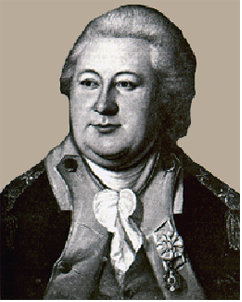Major General
Henry Knox
 Major General Henry Knox was born
in Boston, Massachusetts on July 25, 1750. He attended Boston Latin Grammar School for several years, but was
forced to drop out at age 9 to help support his mother and a younger brother. He became their sole supporter at
age 12 when his father, a shipmaster, died. He worked for a Boston bookseller and spent many of his off-hours
reading military history and engineering.
Major General Henry Knox was born
in Boston, Massachusetts on July 25, 1750. He attended Boston Latin Grammar School for several years, but was
forced to drop out at age 9 to help support his mother and a younger brother. He became their sole supporter at
age 12 when his father, a shipmaster, died. He worked for a Boston bookseller and spent many of his off-hours
reading military history and engineering.
He was a member of "The Train," a Boston Militia artillery unit from the age of 16 and spent several years as co-organizer and second in command of The Boston Grenadier Corps, another militia outfit. When he was 21, Knox started his own bookstore in Boston where he sold, bound, and published books.
At the age 25, and on the recommendation of John Adams, later second President of the U.S., Knox was commissioned a colonel and placed in charge of the Continental Army Artillery by General George Washington, whose trusted subordinate he became.
Knox also served unofficially as General Washington's Master General of Ordnance, and was recognized as such during the war, though never formally appointed. Knox's contributions to Ordnance and to the Army were many and varied. In the winter of 1775-1776, he selected 60 pieces of heavy ordnance from Fort Ticonderoga, New York and brought them to Boston, where for a time they were the only artillery the Army had. He directed the crossing of the Delaware River by the Continental Army during its attack on Trenton, New Jersey, and captured 1,200 prisoners. For this exploit, he was promoted to brigadier general at age 27. He proposed and constructed Springfield Arsenal in 1777 and in 1779 he proposed the establishment of a first military academy.
During most of the war, Knox had charge of all arsenals, magazines, and laboratories, and oversaw civilian manufacturing, procurement, and supply. In 1781, his placement of the artillery at Yorktown did much to ensure the defeat of British forces in that battle. He was promoted to major general in 1782, when he was 32. Knox became commander of the American Army in 1783 when General Washington retired.
He was the first to propose identical uniforms and unit flags for all Army units and first recommended creation of the office of Inspector General. Knox served as the nation's first Secretary of War from 1785 until 1794, and then spent most of the rest of his life in various private business enterprises. He briefly came out of retirement to serve again as a major general during the quasi-war with France (1798), but the emergency passed, and he was not obligated to serve. Major General Knox died on October 25, 1806 at his home in Maine.